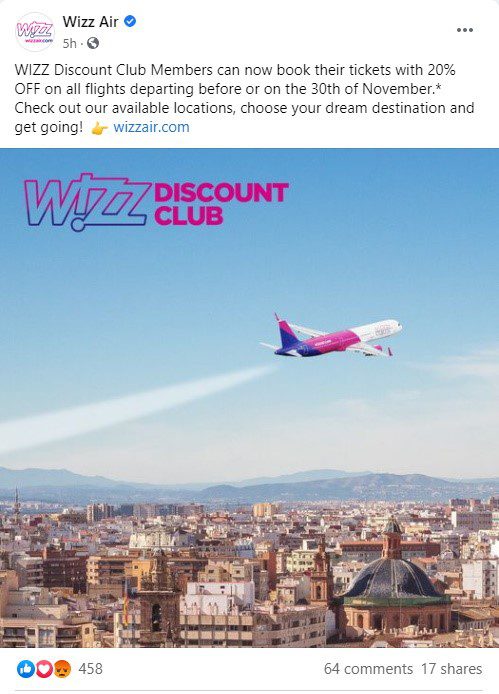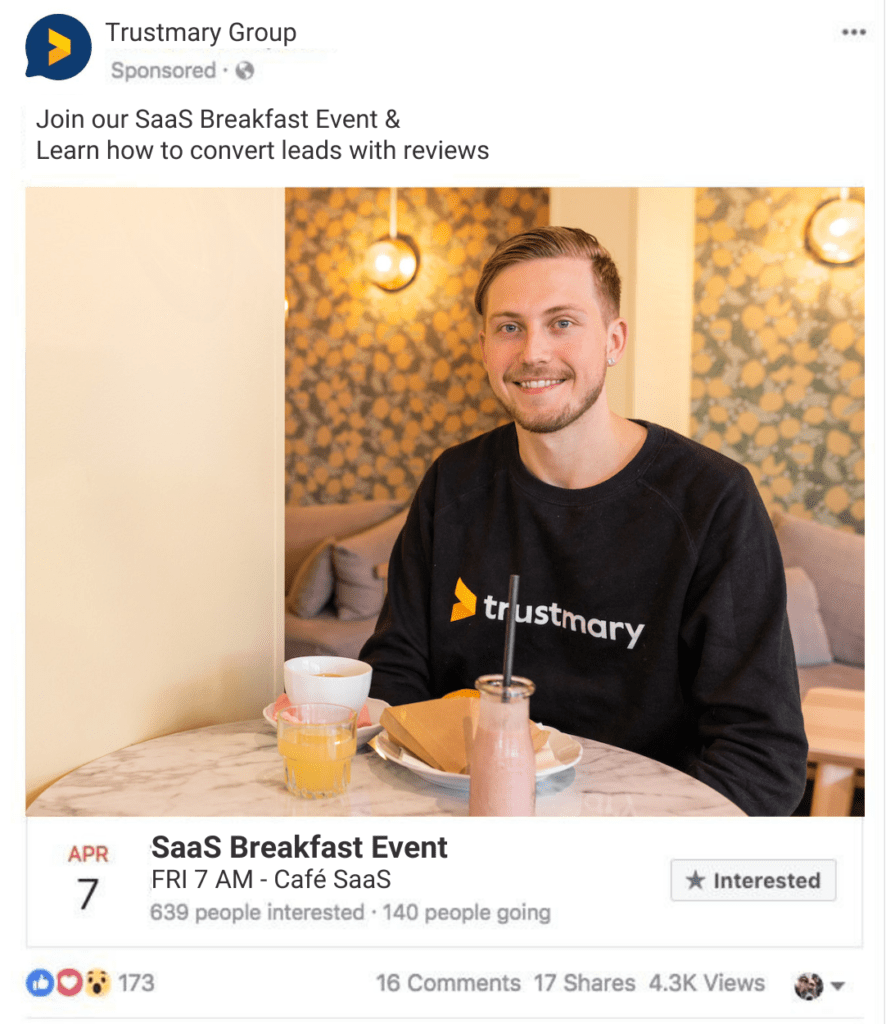5 Examples of Lead Generation Ads on Facebook You Can Rely On


They say that you have to spend money to make some, which couldn't be more accurate.
However, the competition is massive. If you don't play your cards right, you might be spending more than you make. (Track that ROI closely!)
It'd be best if you came up with high-quality Facebook ads that will attract new leads at low prices.
Keep reading, and we'll
- Go over the anatomy of a good lead generation ad in general
- Give you all of the details about lead generation ads on Facebook
- Talk about analyzing and optimizing your results
Facebook Lead Generation Ads: Definition
Facebook lead ads are designed to collect relevant information from potential leads.
Typically, the lead ads include a lead magnet, such as a free ebook or a guide or booking a meeting or consultation, and the users either let Facebook auto-fill their info or they submit it themselves.
This list of leads can then be used to retarget with further campaigns.
Keep in mind to consider how much information you actually need, and only add the absolutely relevant fields. This'll increase your chances of getting leads.
Example Fields to Consider
- Email address
- Name
- Phone number
- Location
Benefits of Using Facebook Lead Gen Ads
Thanks to people willingly submitting their personal information as they sign up to Facebook, marketers can have a field day creating a Facebook lead ads campaign.
Targeting Options Are Endless
If you've done your ground-work correctly in identifying your different ideal customer profiles, you can start targeting them right away.
You can create different ads for different segments based on their location, age, gender, and other interests they've already submitted about themselves.
Mobile-Friendly Format
98,5% of users use Facebook on their mobile phone and 81,8% only ever look at Facebook on their phones.
Luckily, Facebook lead ads campaigns are designed to be mobile-friendly from the get-go.
They are either easy to fill in and/or use the auto-fill options.
5 Examples of Lead Generation Ads on Facebook You Can Rely On
Online retailers have to use everything they can to generate new leads and increase sales. While that can be done in many different ways, one of the most popular and most effective methods is using social media like Facebook to advertise your products and services.
Before diving into the deep end, let's have a look at how a good lead generation ad looks like in general.
The Anatomy of a Good Lead Generation Ad:
There are all kinds of ways and tactics companies use to generate leads, but they have the same structure in the end. Good lead generation starts with capturing the audience's attention with a well-placed incentive and following up with useful information that also needs strong social proof. Here's a quick breakdown of every step in the process.
1) Incentive
Excellent lead generation has to start with the right motive. The customers have to feel like your offer is something they could use. There are many different ways you can relate the incentive to your potential customers.
One of the most effective methods is offering a discount on products and services upon registration. Whatever you decide to do in the end, make sure that you communicate the incentive openly. That can be done with a simple text saying that the readers will get a discount after providing their email address, but images with similar ideas will do just fine.
Another crucial detail is to include a clear call to action. Motivate your visitors to provide their email addresses, and you can't do that without offering something useful in return. Once your visitors enter their email addresses, make sure that they get the discount code or coupon immediately. You must prove that you're a serious company, so there's no room for errors.
2) Visuals
There are all kinds of details you can experiment with when creating a lead generation ad, but none of them are as powerful as a well-placed image. Strategically placed images can help you resonate with your target audience almost more than any other detail in the ad.
But there is more to it than just that. Facebook's algorithm favors ads with images, so you'll get better exposure if you ad an image. Most importantly, images are much more likely to get shared and remembered. With that said, you should make sure that the images you use are appealing and easy to remember.
Don't rush when choosing the perfect image for your ad. Take the time to think about every detail you see and imagine how someone else will feel when they see the image. The emotion has to correlate with your service or product. Most people purchase something driven by emotion rather than black and white information.
Don't hold back when creating the perfect ad image. Show the world how creative you are. The goal is to create a strong bond between your company, offer, and ad. Demonstrate your services or product with an image that focuses on the content's benefits.
Have you tried using visual social proof?
Here's an example of a carousel ad that is used on LinkedIn and Facebook.

3) Copy
When someone runs into your ad, they should be able to click on it and get more information about your services or product. That's a critical stage as you'll get a chance to explain why your offer is better from all others. The key is to make the visitors go to your website and purchase something.
This is where you get the chance to tune in your creativity with your audience. Think about what your audience feels and thinks while reading your ad. You have to put yourself in their shoes to get a better feel of the emotion they go through and change your content accordingly until you evoke the emotions you want. The practice is called customer journey mapping.
After you get a better idea of what your audience is thinking and feeling, your ad copy should complement those emotions. Set the tone by answering questions like:
- What's grabbing the audience's attention?
- Why do you use stats and testimonials?
- What type of language do you use?
Start from there and build your ad up piece by piece.
4) Social proofing
Social proofing is the turning point for any online ad. According to this study, 9 out of 10 customers read user reviews before they make a purchase. It would be best if you made it easier for them by including some social proof in your ads.
When someone runs into your ad on Facebook, they will start checking the facts. That includes the number of likes the ad has and what the users think about the product or service.
Any public social engagement other users can see is some social proof. It can be something as simple as
- a like
- share
- something a little more detailed like a comment or
- review
Like ad copy, social proofing is the backbone of any good ad as it sparks a conversation and engages users.
If a viewer sees an ad with 50+ comments and hundreds of likes, they are much more likely to make a purchase. That's why social proofing is an absolute must for any successful ad campaign, Facebook, or otherwise.
Pro tip: You can collect reviews and testimonials from your customers and use them as social proof content in your ads. See our guide on testimonial advertising to avoid common mistakes and succeed in your campaigns.
5) Targeting
Targeting has come a long way in the past few years. Today, it can provide each individual with the information they find interesting, and the overall experience can be completely different, even though everything happens in the same place. The users are segmented by their affinities, allowing you to present your product or service in the best possible way.
You must align the content with the audience or your ad campaigns won't be very successful. Targeting allows you to pinpoint your specific audience giving you the most out of every Facebook lead ad.
After you know who your audience is, you can create an ad that provides the information they want to see.
You must figure out
- the location
- age
- gender
- language
- interests and
- behavior
of the audience to get the most out of every ad.
Examples of Practical Lead Generation Techniques on Facebook
Now that we've gone through every stage of the Facebook lead ad creating process, here are a few excellent and practical examples of lead generation ads on Facebook.
1. Limited-time offer

Adding some limited-time offers is always a good way of attracting new customers. It puts the customers under 'pressure' as they have to make a choice quickly if they want to get some benefits. These benefits usually come in the form of coupon codes, discounts, and various prizes. If you place an ad with a limited time offer, you will get more control over what is going on.
Your product or service will stay in people's heads, and they will know that the sooner they make a purchase, the cheaper it's going to be. If they can redeem their prize or coupon within a limited time, they won't just forget about it. A precise expiration date will make potential buyers spend money faster than an evergreen discount, and the offer won't eat your profit margin completely.
This strategy is also called FOMO (Fear of Missing Out) marketing. Want to add FOMO also to your website? Check out Trustmary's social proof popup library.
You can also read more on the psychology behind FOMO.
2. Event promotion

Events present an ideal place where you can meet your clients and get more personal with each individual. Holding such an event is usually expensive. It takes a lot of effort to organize, so you must get it right the first time around. You can use Facebook lead ads to ensure that you get the attendance you need while boosting visibility and increasing your sales.
Sure, you can use the local radio, billboards, and other forms of advertising, but nothing will be as useful as a well-placed event promotion Facebook ad. Create an online sign-up process that informs the users about what they are signing up for.
Add an email address form to make it easier for the users to sign up. The best way to promote an event is with a short video that explains everything in more detail. Add prizes or discounts for the first 100 or 200 participants, and your event will be a success for sure.
3. Lead magnets
Finding and capturing new leads is one of the standard strategies of online marketing. While many businesses achieve it with blogs and other similar projects, you can use Facebook to attract new leads just as efficiently.
Lead magnets are somewhat of a win-win situation for both sides. Businesses grow their lead email lists, while users get valuable information that will make their lives easier.
The process can only work if the information you provide is truly valuable. If it's not, visitors will go somewhere else where the offer is more helpful. You will have to spend some time experimenting with different copywriting angles. Keep in mind that the main goal is to promise your target audience useful information if they leave their emails.
So, instead of giving away free stuff and coupon codes, you will give out information your audience can use in the future.
Pay attention to the call to actions as well!
4. Carousel campaigns
Carousel campaigns are one of the most popular Facebook lead ad strategies for capturing new leads. It offers a little more freedom and allows you to address a wider audience at the same time. Instead of showing only one image or video in your ads, carousel campaigns will enable you to add multiple images with different information simultaneously.
That provides you with the perfect way of testing out different copy and visuals. Not only that, but the campaign will also run on multiple channels at the same time, expanding your target audience further. Setting up such a campaign can take a lot of time, but the extra effort will pay off in the end.
5. Lead forms
The lead form feature is a built-in feature on Facebook ads. It's one of the best methods of creating leads because it offers an instant experience within Facebook itself. Instead of sending people to your website, you can get leads through the pre-designed Facebook form, cutting the capturing time to less than 10 seconds.
Facebook's lead form library comes with dozens of pre-designed forms, but you can also create your unique form in minutes. The idea is to provide your audience with a quick and easy way of getting something they need.
A simple questionnaire and a drop-down answer system are all you need to make people leave their email addresses, assuming that your offer is something they want. Unlike a custom questionnaire on your website that takes minutes to complete, you can get the same results in a few seconds by using Facebook's built-in lead forms feature.
Analytics and Optimization
Setting up a Facebook lead generation ad is one thing, but that's only half of the work.
You will also have to keep a close eye on critical metrics to get the most out of every campaign. You can't just focus on the number of total conversions. With the use of analytics tools, you will see how your ads are working in real-time.
Some Facebook ad strategies won't be as useful as others. After you crunch the numbers and get feedback, you can optimize elements to make the campaign even better. Make sure to check how your campaigns are doing as often as possible.
Be ready to make slight changes to optimize the user experience and increase your overall lead generation.
Conclusion
As you can see, many different stages go into creating lead generation ads on Facebook. You must put yourself in the consumer's shoes and think about what you would like to see to understand how to create a profitable Facebook ad campaign.
Even if you get everything right, and the technique you choose gives you good results, you should still keep a close eye on every campaign using analytics tools. No matter how good a campaign might be, there's always some room for improvement.
Now, put your ideas into creative lead generation techniques, and Facebook will help you generate more leads than you ever thought possible. Good luck!
FAQ
How to create lead generation ads on Facebook?
To succeed in lead generation on Facebook, you need to:
- Know your target audience and target them with the ad
- Design a visually appealing ad
- Add social proof
- Analyze the results and improve based on them